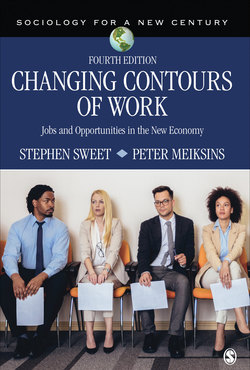Читать книгу Changing Contours of Work - Stephen Sweet - Страница 5
На сайте Литреса книга снята с продажи.
Оглавление1.1 Meg: A Successful Trader Strives to Manage a Demanding Career With a Child Who Has Special Needs3
1.2 Tammy: A Midcareer Manufacturing Worker Attempts to Salvage a Career and a Community4
1.3 Emily: A Contract Worker Navigates Insecure Employment5
1.4 Rain: A Chinese Immigrant Finds Work in the American Food Service Industry6
1.5 Kavita: A Young Indian Woman Navigates Night Work and Call Center Employment7
1.6 Mike: A Disadvantaged Youth Enters a Life of Crime8
1.7 The Film Modern Times Offered a Poignant Illustration of the Alienating Nature of Work in Factory Jobs in the Old Economy14
1.8 Age Distributions and Predicted Distribution in the United States: 1940–206022
2.1 Trends in Employment in Twelve Major Sectors: United States, 1940–201731
2.2 Trends in Employment in Megasectors: United States, 1940–201734
2.3 Percentage of Companies Offering Flexible Work Options to Most or All of Their Employees: United States, 200950
2.4 Percentage of American Workers Who Were Union Members: United States, 1930–201651
2.5 Trade Union Members as Percentage of All Employees: International Comparisons, 201555
3.1 Incomes Received by Each Fifth of Households: 1970–2016 (Prior Years Converted to 2016 Dollar Values)66
3.2 Share of Aggregate Income Received by Each Fifth and Top 5% of Households: 1970 and 201668
3.3 Educational Attainment of Adults, Age Twenty-Five Years and Older: United States, 1970–201675
3.4 Educational Attainment and Synthetic Work-Life Earnings Estimates for All Workers in 200976
3.5 A Schematic of Intergenerational Resource Transfers80
3.6 World Population Projections (in Millions): 1950–205084
3.7 How Value Accumulates in a Global Supply Chain87
3.8 Per Capita Purchasing Power From 1990 to 2016: Comparison of the United States, China, and Ghana89
4.1 Government Public Expenditure as Percentage of Gross Domestic Product: International Comparisons, 2014100
4.2 Unemployment Entitlements: International Comparisons102
4.3 Trends in Mass Layoffs in the United States: 1996–2012105
4.4 Job Security Configurations of Dual-Earner Professional Couples (80% Confidence That Jobs Will Be There in Two Years)108
4.5 Percentage of Displaced Professional Workers Who Received Notification That Their Jobs Would Be Eliminated111
5.1 Use of Time as a Means to Organize Work Remains a Legacy of the Old Economy132
5.2 Percentage of Workers According to Weekly Work Hours: United States, 2016137
5.3 Average Annual Work Hours: International Comparisons, 2016139
5.4 Annual Paid Vacation Days and Paid Holidays: International Comparisons140
5.5 Percentage of Employed Persons Working on Their Main Job at Different Hours of the Day and Night: 2011–2015149
5.6 Patterns of Employment/Hours of American Couples With Children, 2014153
6.1 Men’s and Women’s Labor Force Participation Rates (Age Sixteen Years and Older): United States, 1940–2017165
6.2 Employment Configurations of Married Couples: United States, 2015165
6.3 Women’s and Men’s Earnings (in $1,000s) and Income Ratios for Full-Time Year-Round Workers: United States, 1960–2016 (Earnings Adjusted to 2016 Dollars)167
6.4 Occupations With High Percentages of Women Workers: United States, 2014172
6.5 Gender Compositions of Bachelor’s Degrees Conferred: United States, 2014–2015174
6.6 Percentage of Husbands and Wives Reporting That Their Career Was Favored Over Their Spouse’s Career (by Life Stage)176
6.7 Converging Divergences in Women’s and Men’s Values and Preferences Over Time178
6.8 Instead of Hiring This Woman, Most College Students Would Hire an Equally Qualified Man. Would You?182
6.9 Last Week Tonight With John Oliver Writers Receive Their Emmys in 2017: Why Are There So Few Women?188
6.10 Two Different Job Descriptions: Why Does One Job Pay Less Than the Other?189
6.11 Health Benefits of Breastfeeding194
6.12 Statutory Family Leave Entitlements in Developed Countries198
7.1 An Editorial Showing Fear of Immigrants (Circa 1860)209
7.2 Mean Income of Men With Earnings: United States, 1970–2016 (Adjusted to 2016 Dollars)212
7.3 Mean Income of Women With Earnings: United States, 1970–2016 (Adjusted to 2016 Dollars)213
7.4 Percentage of People Living Below the Poverty Line: United States, 2016214
7.5 Percentage of Households Owning Select Assets by Race: United States, 2013217
7.6 Percentage Graduating From College (Age Twenty-Five Years and Older) by Race: United States, 1970–2017219
7.7 Unauthorized Immigrants as Percentages of Workers in Select Occupations: United States, 2014241
8.1 Organized Protests Provide Visibility to Labor Concerns254
